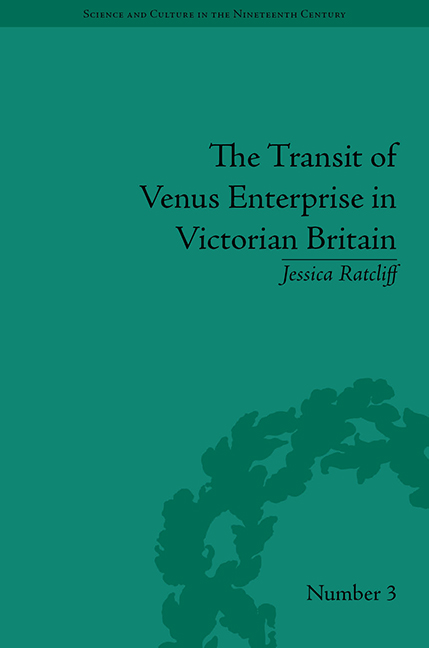Refine search
Actions for selected content:
10306 results in History of science: general interest
Acknowledgments
-
- Book:
- Recreating Newton
- Published by:
- Pickering & Chatto
- Published online:
- 05 December 2014, pp vii-vii
-
- Chapter
- Export citation
5 - Looking as Tourists and Scientists: Amelia Edwards, Flinders Petrie and the Archaeology of the Egypt Exploration Fund
- from Part III - Past
-
- Book:
- Vision, Science and Literature, 1870–1920
- Published by:
- Pickering & Chatto
- Published online:
- 05 December 2014, pp 115-142
-
- Chapter
- Export citation
Introduction
-
- Book:
- Communicating Physics
- Published by:
- Pickering & Chatto
- Published online:
- 05 December 2014, pp 1-10
-
- Chapter
- Export citation
I - Representations
-
- Book:
- James Watt, Chemist
- Published by:
- Pickering & Chatto
- Published online:
- 05 December 2014, pp -
-
- Chapter
- Export citation
Works Cited
-
- Book:
- The Aliveness of Plants
- Published by:
- Pickering & Chatto
- Published online:
- 05 December 2014, pp 209-220
-
- Chapter
- Export citation
Preface
-
- Book:
- The Historiography of the Chemical Revolution
- Published by:
- Pickering & Chatto
- Published online:
- 05 December 2014, pp x-xiv
-
- Chapter
- Export citation
1 - Textbooks and the Cultures Of Physics
-
- Book:
- Communicating Physics
- Published by:
- Pickering & Chatto
- Published online:
- 05 December 2014, pp 11-22
-
- Chapter
- Export citation
6 - Atkinson's Physics
-
- Book:
- Communicating Physics
- Published by:
- Pickering & Chatto
- Published online:
- 05 December 2014, pp 149-170
-
- Chapter
- Export citation
4 - The Value of Beer
-
- Book:
- Brewing Science, Technology and Print, 1700–1880
- Published by:
- Pickering & Chatto
- Published online:
- 05 December 2014, pp 83-106
-
- Chapter
- Export citation
Index
-
- Book:
- Recreating Newton
- Published by:
- Pickering & Chatto
- Published online:
- 05 December 2014, pp 275-286
-
- Chapter
- Export citation
Acknowledgements
-
- Book:
- The Historiography of the Chemical Revolution
- Published by:
- Pickering & Chatto
- Published online:
- 05 December 2014, pp vii-ix
-
- Chapter
- Export citation
Frontmatter
-
- Book:
- Recreating Newton
- Published by:
- Pickering & Chatto
- Published online:
- 05 December 2014, pp i-iv
-
- Chapter
- Export citation

The Transit of Venus Enterprise in Victorian Britain
-
- Published by:
- Pickering & Chatto
- Published online:
- 05 December 2014
-
- Book
- Export citation
List of Illustrations
-
- Book:
- The Transit of Venus Enterprise in Victorian Britain
- Published by:
- Pickering & Chatto
- Published online:
- 05 December 2014, pp ix-ix
-
- Chapter
- Export citation
Acknowledgements
-
- Book:
- Science and Societies in Frankfurt am Main
- Published by:
- Pickering & Chatto
- Published online:
- 05 December 2014, pp ix-x
-
- Chapter
- Export citation
4 - Museums and exhibitions
-
- Book:
- Communities of Science in Nineteenth-Century Ireland
- Published by:
- Pickering & Chatto
- Published online:
- 05 December 2014, pp 101-130
-
- Chapter
- Export citation
Introduction: John Tyndall, Scientific Naturalism and Modes of Communication
-
-
- Book:
- The Age of Scientific Naturalism
- Published by:
- Pickering & Chatto
- Published online:
- 05 December 2014, pp 1-14
-
- Chapter
- Export citation
List of Contributors
-
- Book:
- Popular Exhibitions, Science and Showmanship, 1840–1910
- Published by:
- Pickering & Chatto
- Published online:
- 05 December 2014, pp xi-xiv
-
- Chapter
- Export citation
Works Cited
-
- Book:
- Communities of Science in Nineteenth-Century Ireland
- Published by:
- Pickering & Chatto
- Published online:
- 05 December 2014, pp 199-214
-
- Chapter
- Export citation
Frontmatter
-
- Book:
- Communities of Science in Nineteenth-Century Ireland
- Published by:
- Pickering & Chatto
- Published online:
- 05 December 2014, pp i-vi
-
- Chapter
- Export citation
